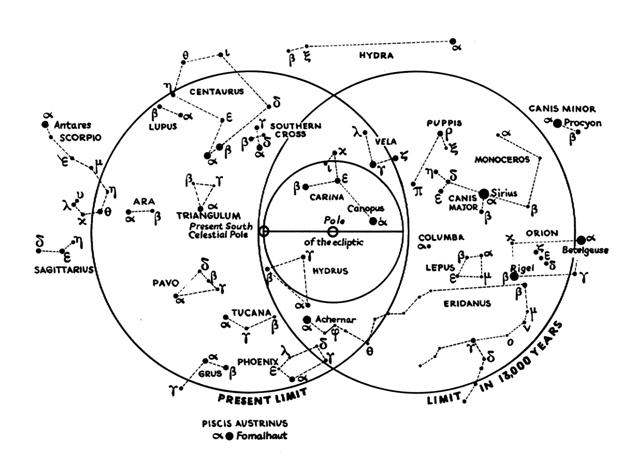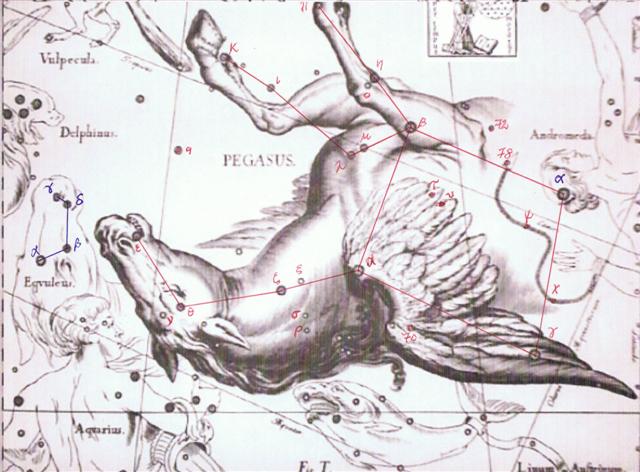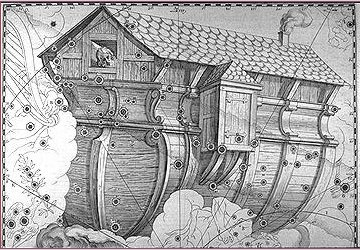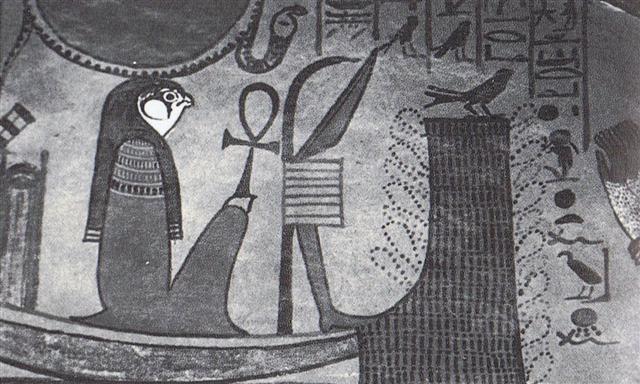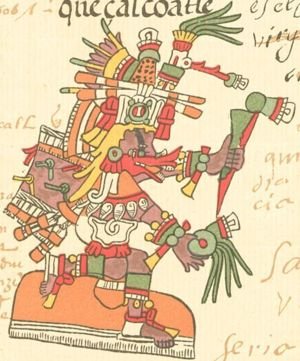37. A star walker needs a pair of fixed points for orientation. The Southern Cross should be one of them, a natural choice for people on Easter Island: ... Whittier said, in his Cry of a Lost Soul: 'The Cross of pardon lights the tropic skies'; which is correct for our day, as it is not now entirely visible above 27º 30' of north latitude. It was last seen on the horizon of Jerusalem - 31º 46' 45'' - about the time that Christ was crucified. But 3000 years previously all its stars were 7º above the horizon of the savages along the shores of the Baltic Sea, in latitude 52º 30' ... Although Canopus was closer to the pole of the ecliptic. And Spica (*202) - Canopus (*95) = *107 = 471 - 364.
Another convenient point would have been Hamal, the Prince, who came in the corresponding place on side b of the C text. I.e. in position 4 counted from Polaris:
We know the creator of the G text had placed heliacal Sirius on side a of his tablet and nakshatra Sirius on side b - although pushed ahead with 23 days corresponding to the precessional distance down from the time of Gregory XIII to that of Julius Caesar: ... The distance from the first fish-hook to the second is not 183 days but 183 + 23 = 206 days:
Probably the creator of the G text has here indicated the precessional distance down to Roman times when the Julian calendar established the correct relationships between the stars and the dates ... The idea may have been to describe at first the upper kingdom (Hanan) and then the lower domain (Hurin). ... The 'pontificial world' (Pontifical Mundo) has Peru at the top and Spain at bottom, in both cases with the central edifices occupying the place of the Sun. Wright explains: [This is] Waman Puma's conception of the relationship between Peru and Spain according to the Andean duality principle of Hanan (Upper) and Hurin (Lower). Each country is shown as a Tawantinsuyu - four quarters with a capital in the center. Peru is higher, closer to the sun, and therefore full of gold, the 'sweat of the sun' ... ... The 'present' age in Peru begins with the appearance of Manku Qhapaq, the first Inca, a being of supernatural origin. And in the Old World the 'present' starts with the birth of Jesus Christ ... If so, we can expect the creator of the C tablet to have used a similar mental map. Terminalia at the Full Moon (Ca1-1) could mean the Sun was at the opposite place - at his beginning. Which means at day 54 ('February 23) + 183 = 237 ('August 25) = 8 * 29½ + 1.
There are 242 glyphs on side b of the G tablet and 242 - 6 = 236 ('August 24) = 4 * 59.
The Wing of the Pegasus horse was where the Babylonians had their 1-iku constellation, ruled by Anunitum (τ Piscium) - and the Wing (Gienah) of Raven was when in rongorongo times the Sun reached the southern spring equinox in September.
... The 2nd fish to rise in Pisces was Anunitum (τ) - with a sign of the planet Venus close by:
... Though Andromeda has its roots most firmly in the Greek tradition, a female figure in Andromeda's place appeared in Babylonian astronomy. The stars that make up Pisces and the middle portion of modern Andromeda formed a constellation representing a fertility goddess, sometimes named as Anunitum or the Lady of the Heavens ...
On Easter Island it was the sooty tern, the sea swallow, manu tara, who arrived on wings with spring - like the bird sent out by Noah:
Swallows are swallowing insects (the souls of the unborn) and their return in spring should mean the return of the spirits to Mother Nature. ... Now birds and fishes are born under the sign of the Yin, but they belong to the Yang. This is why birds and fishes both lay eggs. Fishes swim in the waters, birds fly among the clouds. But in winter, the swallows and starlings go down into the sea and change into mussels ...
... The bereaved and sorrowing Isis, meanwhile, wandering over the world in her quest - like Demeter in search of the lost Persephone - came to Byblos, where she learned of the wonderful tree. And, placing herself by a well of the city, in mourning, veiled and in humble guise - again like Demeter - she spoke to none until there approached the well the handmaidens of the queen, whom she greeted kindly. Braiding their hair, she breathed upon them such a wondrous perfume that when they returned and Astarte saw and smelt the braids she sent for the stranger, took her into the house, and made her the nurse of her child. The great goddess gave the infant her finger instead of breast to suck and at night, having placed him in a fire to burn away all that was mortal, flew in the form of a swallow around the pillar, mournfully chirping. But the child's mother, Queen Astarte, happening in upon this scene, shrieked when she spied her little son resting in the flames and thereby deprived him of the priceless boon. Whereupon Isis, revealing her true nature, begged for the pillar and, removing the sarcophagus, fell upon it with a cry of grief so loud that the queen's child died on the spot. Sorrowing, then, the two women placed Osiris's coffer on a boat, and when the goddess Isis was alone with it at sea, she opened the chest and, laying her face on the face of her brother, kissed him and wept ... Wings (birds) defined the primary cardinal points, first of all spring equinox with a sweet smelling gentle breeze (breath). ... The dream soul climbed up and reached the rim of the crater. As soon as the dream soul looked into the crater, she felt a gentle breeze coming toward her. She named the place Poko Uri A Hau Maka O Hiva ... ... Makoi got up and began to familiarize himself with the (new) land. (This took place) on the fifteenth day of the month of June ('Maro'). He went toward the sheer face of the rocks (titi o te opata), was astonished (aaa), came up to the middle (of the outer rim of the crater), and stood at the very edge. He looked down and saw the Pu Mahore of Hau Maka (on the coast) and said, 'There it is, the hole of the mahore fish of Hau Maka!' He turned his face and looked toward the back (i.e., in the direction of the crater). No sooner had he seen how the dark abyss opened up (below him), when a fragrant breeze came drifting by. Again Makoi said, 'This is the dark abyss of Hau Maka' ...
... Suddenly, from the island of Paxi was heard the voice of someone loudly calling Thamus [Dumuzi, Aries], so that all were amazed. Thamus was an Egyptian pilot, not known by name to many on board. Twice he was called and made no reply, but the third time he answered; and the caller, raising his voice, said, 'When you come opposite to Palodes, announce that Great Pan is dead.' On hearing this, all, said Epitherses, were astounded and reasoned among themselves whether it were better to carry out the order or to refuse to meddle and let the matter go. Under the circumstances Thamus made up his mind that if there should be a breeze, he would sail past and keep quiet, but with no wind and a smooth sea about the place he would announce what he had heard. So, when he came opposite Palodes, and there was neither wind nor wave, Thamus from the stern, looking toward the land, said the words as he heard them: 'Great Pan is dead'. Even before he had finished there was a great cry of lamentation, not of one person, but of many, mingled with exclamations of amazement. As many persons were on the vessel, the story was soon spread abroad in Rome, and Thamus was sent for by Tiberius Caesar. Tiberius became so convinced of the truth of the story that he caused an inquiry and investigation to be made about Pan; and the scholars, who were numerous at his court, conjectured that he was the son born of Hermes and Penelope ...
Up (Egyptian south, at right in the picture) and Egyptian north (down, at left in the picture) could appear to be like mirror images, but a plane mirror cannot reverse what is up to become down, only change east into west: ... the great high priest and monarch of the Golden Age in the Toltec city of Tula, the City of the Sun, in ancient Mexico, whose name, Quetzalcoatl, has been read to mean both 'the Feathered Serpent' and 'the Admirable Twin', and who was fair of face and white of beard, was the teacher of the arts to the people of pre-Columbian America, originator of the calendar, and their giver of maize. His virgin mother, Chimalman - the legend tells - had been one of the three sisters to whom God, the All-Father, had appeared one day under his form of Citlallatonac, 'the morning'. The other two had been struck by fright, but upon Chimalman God breathed and she conceived. She died, however, giving birth, and is now in heaven, where she is revered under the honourable name of 'the Precious Stone of Sacrifice', Chalchihuitzli.
Quetzalcoatl, her child, who is known both as the Son of the Lord of the High Heavens and as the Son of the Lord of the Seven Caves, was endowed at birth with speech, all knowledge, and all wisdom, and in later life, as priest-king, was of such purity of character that his realm flourished gloriously throughout the period of his reign. His temple-palace was composed of four radiant apartments: one toward the east, yellow with gold; one towards the west, blue with turquoise and jade; one toward the south, white with pearls and shells; one towards the north, red with bloodstones - symbolizing the cardinal quarters of the world over which the light of the sun holds sway. And it was set wonderfully above a mighty river that passed through the midst of the city of Tula; so that every night, precisely at midnight, the king descended into the river to bathe; and the place of his bath was called 'In the Painted Vase', or 'In the Precious Waters'. But the time of his predestined defeat by the dark brother, Tezcatlipoca, was ever approaching, and, knowing perfectly the rhythm of his own destiny, Quetzalcoatl would make no move to stay it. Tezcatlipoca, therefore, said to his attendants, 'We shall give him a drink to dull his reason and show him his own face in a mirror; then, surely, he will be lost'. And he said to the servants of the good king, 'Go tell your master that I have come to show him his own flesh!' But when the message was brought to Quetzalcoatl, the aging monarch said, 'What does he call my own flesh? Go and ask!' And when the other was admitted to his presence: 'What is this, my flesh, that you would show me?' Tezcatlipoca answered, 'My Lord and Priest, look now at your flesh; know yourself; see yourself as you are seen by others!' And he presented the mirror. Whereupon, seeing his own face in that mirror, Quetzalcoatl immediately cried out, 'How is it possible that my subjects should look upon me without fright? Well might they flee from before me. For how can a man remain among them when he is filled as I am with foul sores, his old face wrinkled and of an aspect so loathsome? I shall be seen no more, I shall no longer terrify my people'. Presented the drink to quaff, he refused it, saying that he was ill; but urged to taste it from the tip of his finger, he did so and was immediately overpowered by its magic. He lifted the bowl and was drunk. He sent for Quetzalpetlatl, his sister, who dwelt on the Mountain Nonoalco. She came, and her brother gave her the bowl, so that she too was drunk. And with all reason forgotten, the two that night neither said prayers nor went to the bath, but sank asleep together on the floor. And in the morning Quetzalcoatl said, in shame, 'I have sinned [hakaturou]; the stain of my name cannot be erased. I am not fit to rule this people. Let them build a habitation for me deep under the ground; let them bury my bright treasures in the earth; let them throw the glowing gold and shining stones into the Precious Waters where I take my nightly bath. And all this was done. The king remained four days in his underground tomb, and when he came forth he wept and told his people that the time had come for his departure to the Red Land, the Dark Land, the Land of Fire. Having burned his dwellings behind him, buried his treasures in the mountains, transformed his chocolate trees into mesquite, and commanded his multicolored birds to fly before him, Quetzalcoatl, in great sorrow, departed. Resting at a certain place along the way and looking back in the direction of Tula, his City of the Sun, he wept, and his tears went through a rock [creating sinkholes]; he left in that place the mark of his sitting and the impress of his palms. Farther along, he was met and challenged by a company of necromancers, who prevented him from proceeding until he had left with them the arts of working silver, wood, and feathers, and the art of painting. As he crossed the mountains, many of his attendants, who were dwarfs and humpbacks, died of the cold. At another place he met his dark antagonist, Tezcatlipoca, who defeated him at a game of ball. At still another he aimed with an arrow at a large pochotl tree; and the arrow too was a pochotl tree, so that when he shot it through the first they formed a cross [†]. And so he passed along, leaving many signs and place-names behind him, until, coming at last to where the sky, land, and water come together, he departed. He sailed away on a raft of serpents, according to one version, but another has it that his remaining attendants built a funeral pyre, into which he threw himself, and while the body burned, his heart departed and after four days appeared as the rising planet Venus. All agree, however, that he will presently return. He will arrive with a fair-faced retinue from the east and resume sway over his people; for although Tezcatlipoca had conquered, those immutable laws that had determined the destruction of Tula assigned likewise its restoration. Quetzalcoatl was not dead. In one of his statues he was shown reclining, covered with wrappings, signifying that he was absent or 'as one who lays him down to sleep, and that when he should wake from that dream of absence, would rise to rule again the land'. He had built mansions underground to the Lord of Mictlan, the lord of the dead, but did not occupy these himself, dwelling, rather, in that land of gold where the sun abides at night. This too, however, is underground. Certain caverns lead to it, one of which, called Cincalco, 'To the Abode of Abundance', is south of Chapultepec; and through its gloomy corridors men can reach that happy land, the habitation of the sun, which is still ruled by Quetzalcoatl. Moreover, that land is the land from which he came in the beginning... All this, which in so many ways parallels the normal imagery of the Old World culture-hero myths, telling of the one who is gone, dwells underground in a happy, timeless land, as lord of the realm of the happy dead, like Osiris, but will rise again, we can read without surprise. But what is surprising indeed was the manner of Quetzalcoatl's actual return. The priests and astrologers did not know in what cycle he was to reappear; however, the name of the year within the cycle had been predicted, of old, by Quetzalcoatl himself. Its sign was 'One Reed' (Ce Acatl), which, in the Mexican calendar, is a year that occurs only once in every cycle of fifty-two. But the year when Cortes arrived, with his company of fair-faced companions and his standard, the cross, was precisely the year 'One Reed'. The myth of the dead and resurrected god had circumnavigated the globe ...
|
|||||||||||||||||||||||||||||||||||||||||||||||||||||||||||||||||||||||||||||||||||||||||||||||||||||||||||||||||||||||||||||||||||||||||||||||||||||||||||||||||||||||||||||||||||||||||||||||||||||||||||||||||||||||||||||||||||||||||||||||||||||||||||||||||||||||||||||
